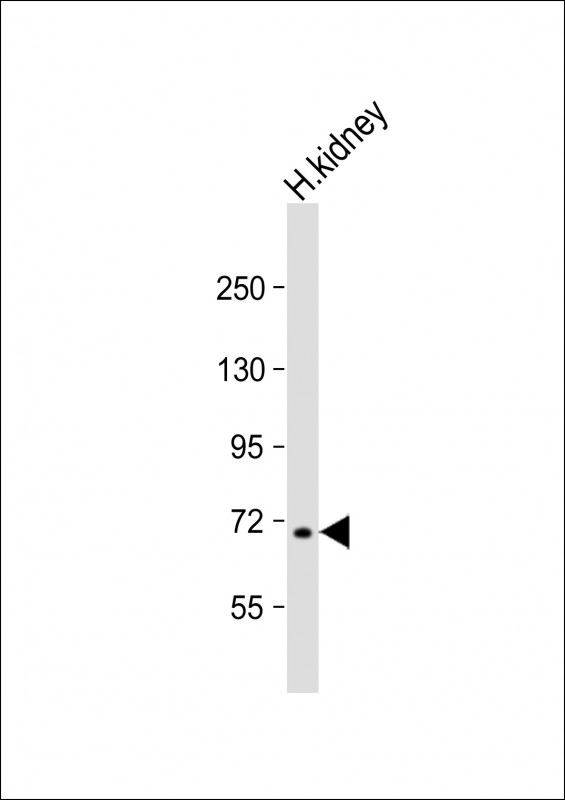MLL5 Antibody (N-term)
Affinity Purified Rabbit Polyclonal Antibody (Pab)
- SPECIFICATION
- CITATIONS: 2
- PROTOCOLS
- BACKGROUND

Application
| WB, E |
|---|---|
| Primary Accession | Q8IZD2 |
| Other Accession | Q3UG20, Q8NFF8, NP_891847.1, NP_061152.3, Q9NS29 |
| Reactivity | Human |
| Predicted | Mouse |
| Host | Rabbit |
| Clonality | Polyclonal |
| Isotype | Rabbit IgG |
| Calculated MW | 204965 Da |
| Antigen Region | 93-120 aa |
| Gene ID | 55904 |
|---|---|
| Other Names | Histone-lysine N-methyltransferase 2E, Lysine N-methyltransferase 2E, Myeloid/lymphoid or mixed-lineage leukemia protein 5, KMT2E, MLL5 |
| Target/Specificity | This MLL5 antibody is generated from rabbits immunized with a KLH conjugated synthetic peptide between 93-120 amino acids from the N-terminal region of human MLL5. |
| Dilution | WB~~1:1000 |
| Format | Purified polyclonal antibody supplied in PBS with 0.09% (W/V) sodium azide. This antibody is purified through a protein A column, followed by peptide affinity purification. |
| Storage | Maintain refrigerated at 2-8°C for up to 2 weeks. For long term storage store at -20°C in small aliquots to prevent freeze-thaw cycles. |
| Precautions | MLL5 Antibody (N-term) is for research use only and not for use in diagnostic or therapeutic procedures. |
| Name | KMT2E |
|---|---|
| Synonyms | MLL5 |
| Function | Associates with chromatin regions downstream of transcriptional start sites of active genes and thus regulates gene transcription (PubMed:23629655, PubMed:24130829, PubMed:23798402). Chromatin interaction is mediated via the binding to tri-methylated histone H3 at 'Lys-4' (H3K4me3) (PubMed:24130829, PubMed:23798402). Key regulator of hematopoiesis involved in terminal myeloid differentiation and in the regulation of hematopoietic stem cell (HSCs) self-renewal by a mechanism that involves DNA methylation (By similarity). Also acts as an important cell cycle regulator, participating in cell cycle regulatory network machinery at multiple cell cycle stages including G1/S transition, S phase progression and mitotic entry (PubMed:14718661, PubMed:18573682, PubMed:19264965, PubMed:23629655). Recruited to E2F1 responsive promoters by HCFC1 where it stimulates tri-methylation of histone H3 at 'Lys-4' and transcriptional activation and thereby facilitates G1 to S phase transition (PubMed:23629655). During myoblast differentiation, required to suppress inappropriate expression of S-phase-promoting genes and maintain expression of determination genes in quiescent cells (By similarity). |
| Cellular Location | Chromosome. Cytoplasm, cytoskeleton, microtubule organizing center, centrosome. Nucleus speckle. Note=Absent from the nucleolus (PubMed:14718661). Localizes to chromosome during interphase and to centrosomes during mitosis (PubMed:23798402). Dissociation from mitotic chromosome is likely due to histone H3 phosphorylation on 'Thr-3' and 'Thr-6' (PubMed:23798402). [Isoform NKp44L]: Cytoplasm. Cell membrane; Peripheral membrane protein |
| Tissue Location | Widely expressed in both adult and fetal tissues (PubMed:12101424, PubMed:23958951). Highest levels of expression observed in fetal thymus and kidney and in adult hematopoietic tissues, jejunum and cerebellum (PubMed:12101424, PubMed:23958951). Isoform NKp44L: Not detected on circulating cells from healthy individuals, but is expressed on a large panel of tumor and transformed cells (PubMed:23958951). |

Provided below are standard protocols that you may find useful for product applications.
Background
This gene is a member of the myeloid/lymphoid or mixed-lineage leukemia (MLL) family and encodes a protein with an N-terminal PHD zinc finger and a central SET domain. Overexpression of the protein inhibits cell cycle progression. Alternate transcriptional splice variants have been characterized. [provided by RefSeq].
References
Liu, J., et al. J. Biol. Chem. 285(27):20904-20914(2010)
Fujiki, R., et al. Nature 459(7245):455-459(2009)
Cheng, F., et al. Int. J. Biochem. Cell Biol. 40(11):2472-2481(2008)
Sun, X.J., et al. PLoS ONE 3 (1), E1499 (2008) :
Olsen, J.V., et al. Cell 127(3):635-648(2006)
If you have used an Abcepta product and would like to share how it has performed, please click on the "Submit Review" button and provide the requested information. Our staff will examine and post your review and contact you if needed.
If you have any additional inquiries please email technical services at tech@abcepta.com.














 Foundational characteristics of cancer include proliferation, angiogenesis, migration, evasion of apoptosis, and cellular immortality. Find key markers for these cellular processes and antibodies to detect them.
Foundational characteristics of cancer include proliferation, angiogenesis, migration, evasion of apoptosis, and cellular immortality. Find key markers for these cellular processes and antibodies to detect them. The SUMOplot™ Analysis Program predicts and scores sumoylation sites in your protein. SUMOylation is a post-translational modification involved in various cellular processes, such as nuclear-cytosolic transport, transcriptional regulation, apoptosis, protein stability, response to stress, and progression through the cell cycle.
The SUMOplot™ Analysis Program predicts and scores sumoylation sites in your protein. SUMOylation is a post-translational modification involved in various cellular processes, such as nuclear-cytosolic transport, transcriptional regulation, apoptosis, protein stability, response to stress, and progression through the cell cycle. The Autophagy Receptor Motif Plotter predicts and scores autophagy receptor binding sites in your protein. Identifying proteins connected to this pathway is critical to understanding the role of autophagy in physiological as well as pathological processes such as development, differentiation, neurodegenerative diseases, stress, infection, and cancer.
The Autophagy Receptor Motif Plotter predicts and scores autophagy receptor binding sites in your protein. Identifying proteins connected to this pathway is critical to understanding the role of autophagy in physiological as well as pathological processes such as development, differentiation, neurodegenerative diseases, stress, infection, and cancer.

